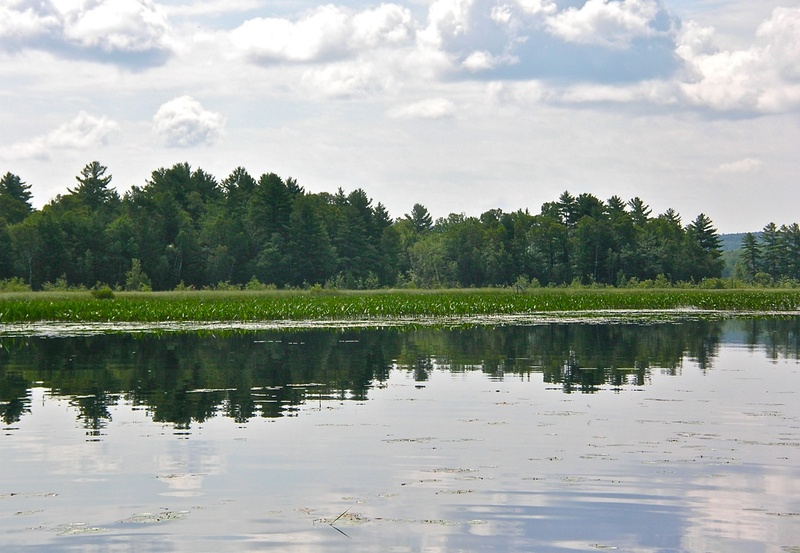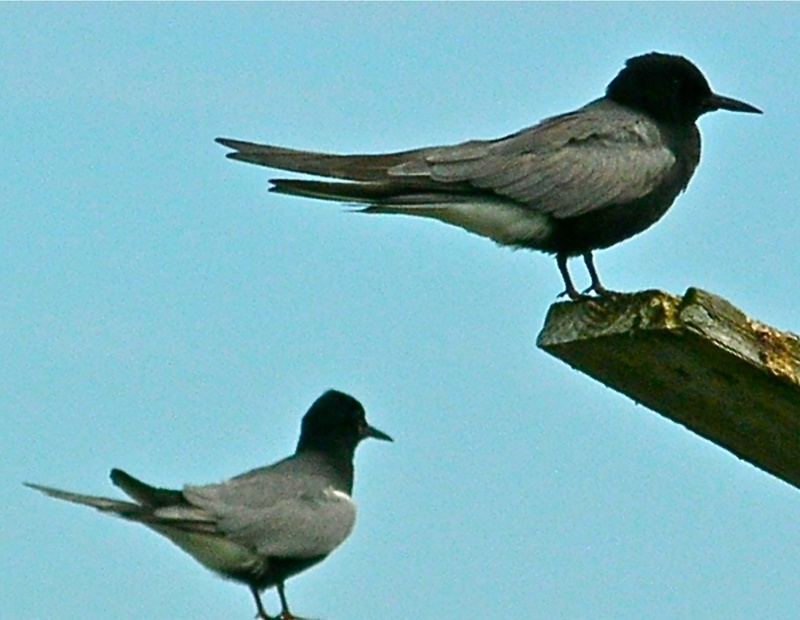Enjoy a taste of nature’s ballet this month with a paddling outing on Carlton Bog in Troy.
Carlton Bog is one of only a few areas in Maine where the acrobatic black tern nests. There are about 25 nesting pairs spread about this 1,055-acre manmade bog. They are amazing to watch; flitting to and fro, changing direction on a dime, hovering a few feet over the water.
Black terns have a dark black head, lighter black and gray body, and white wing edges; a combination that is striking in flight. The terns nest on floating mats of vegetation, and there is plenty of that at Carlton Bog.
The bog is shaped like a boomerang. There are distinct open channels of water in each arm if you want vegetation-free paddling. But to examine the profusion of bog grasses, flowers and plants along the shoreline you will have to paddle through some dense carpets of lily pads and pickerelweed.
Yellow pond-lilies are everywhere. Mats of white water lilies send forth intoxicatingly sweet fragrances as you paddle near them.
You will encounter a few fishermen enjoying the challenge of landing a big bass or pickerel. We met an 8-year-old who had recently caught a 6-pound, 21-inch bass at the bog. As we were talking with him, we heard a loud yell and turned around to see a bass ferociously take another fisherman’s lure and literally bend the rod under the canoe. We were quite impressed with the Carlton Bog fishery.
To get to Carlton Bog from the Fairfield area, follow Route 139 east for 15 miles to Unity. Follow Route 202 four miles into Troy. Turn left onto Route 220 and follow it north for three miles. At the bottom of a steep hill turn right onto the gravel Bog Road just before the outlet stream of Carlton Bog. A small parking area on the right is located a half-mile down the Bog Road adjacent to the put-in spot. Consult the Delorme Maine Atlas and Gazetteer map #22 for help in getting there.
Put in at the large metal culvert a few yards east of the parking area. We were no sooner in the water than we looked up to see an immature bald eagle flying over us.
Your experience on the bog will be one of sounds as well as sights; the deep-throated calls of bullfrogs mixing with the unmistakable trilling of red-winged blackbirds, the splash of large fish snatching insects from the water surface combining with the scratching sound of lily leaves sliding along your canoe hull. We explored both arms of the bog on a recent Sunday morning, covering seven miles over a three-hour period.
The easterly arm has more vegetation on its surface and will offer a little more resistance as you paddle the circumference of the arm.
The bog is surrounded by acres of wet grasslands bordered by forest along its outer reaches. We found only one spot (in the eastern arm) where any trees came down to the water to provide a small solid area to get out and stretch.
As we reached the northern end of the arm, we spied a rusty red boulder planted in the middle of the waterside grasses. Our binoculars turned our boulder into a large deer feeding in the grasses. We watched it meander through the tall grasses, disappearing for a few seconds, then appearing a few yards away.
The western arm is larger and provides a fun challenge at its northern end. See how far you can follow the narrowing arm up into its shallow inlet stream. We eventually were surrounded by cattails and rushes, our paddles flailing away on the reeds. Swallowed up by the grasses and the sounds of nature we felt if we might have been the last people left on Earth.
We sat and soaked in the sounds and sweet aromas, and reveled in the slowly rising morning heat caressing our bodies. It seemed all so perfect; nature had completely taken us in.
On the way back out into the open waters of the western arm we encountered another large deer, neck-deep in water, peacefully foraging. We glided by without disturbing it, all the while marveling at the incredible deep reddish brown color of its shiny coat.
The delicate pink flower heads of rose pogonias poked up through the tall waterside grasses. Freshly cut cattail reeds and grasses floated in the water near muddy patches strewn with freshwater clam shells, unmistakable signs that the muskrats are dining well at Carlton Bog.
Before heading back in, be sure to paddle down into the small cove leading to the earthen dam on the southwestern corner of the bog that creates this vast impoundment. The only island in the whole bog is here, a tiny rocky islet with a solitary pine at its rounded crest. This is a great spot to get out and relax in the shade and reflect on the wonderful things you have seen and heard out on the bog.
Another nice feature of this outing is the drive to the bog though the rolling farm country south of Bangor. There are many beautiful old barns scattered about, lots of turkeys and their tiny youngsters crossing the roads and an amazing peacefulness and timelessness that will have you plotting retirement and your next real estate purchase.
Michael Perry is the former director of the L.L.Bean Outdoor Discovery Schools, and founder of Dreams Unlimited, specializing in inspiring outdoor slide programs for civic groups, businesses and schools. He can be contacted at:
dreams@suscom-maine.net
Send questions/comments to the editors.




Success. Please wait for the page to reload. If the page does not reload within 5 seconds, please refresh the page.
Enter your email and password to access comments.
Hi, to comment on stories you must . This profile is in addition to your subscription and website login.
Already have a commenting profile? .
Invalid username/password.
Please check your email to confirm and complete your registration.
Only subscribers are eligible to post comments. Please subscribe or login first for digital access. Here’s why.
Use the form below to reset your password. When you've submitted your account email, we will send an email with a reset code.